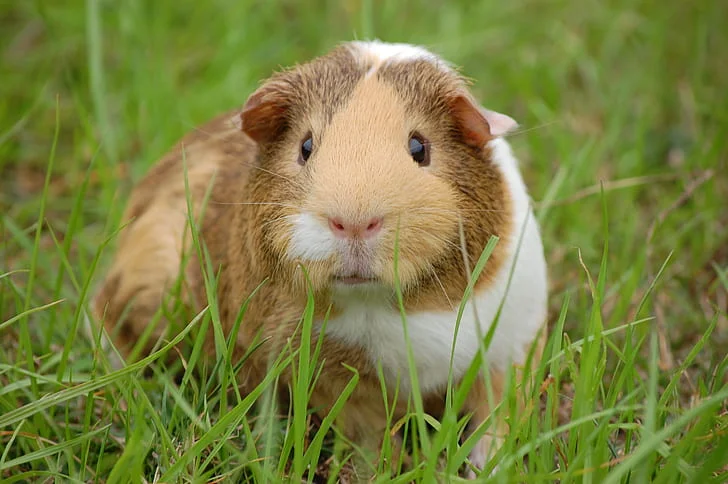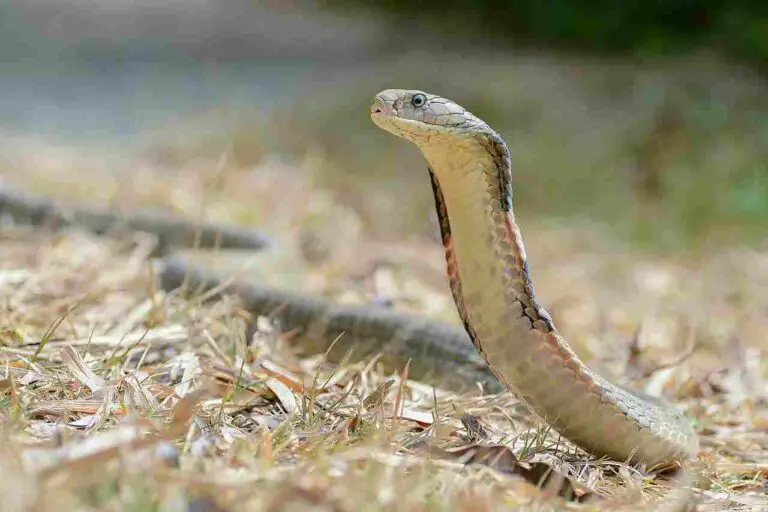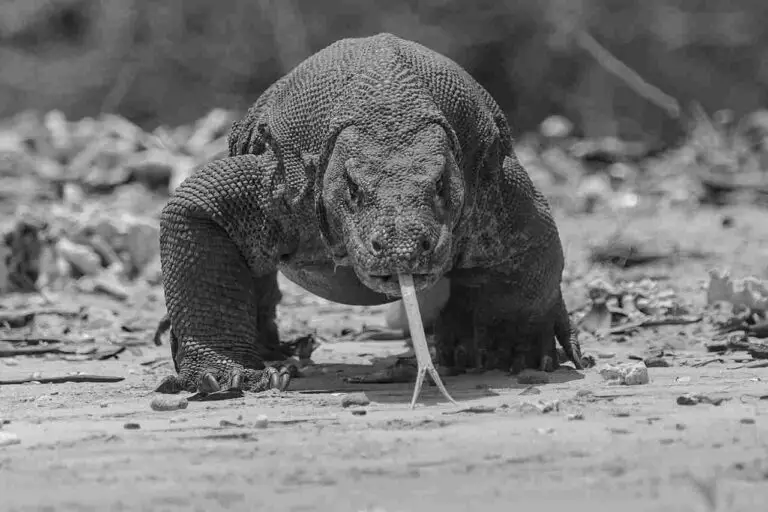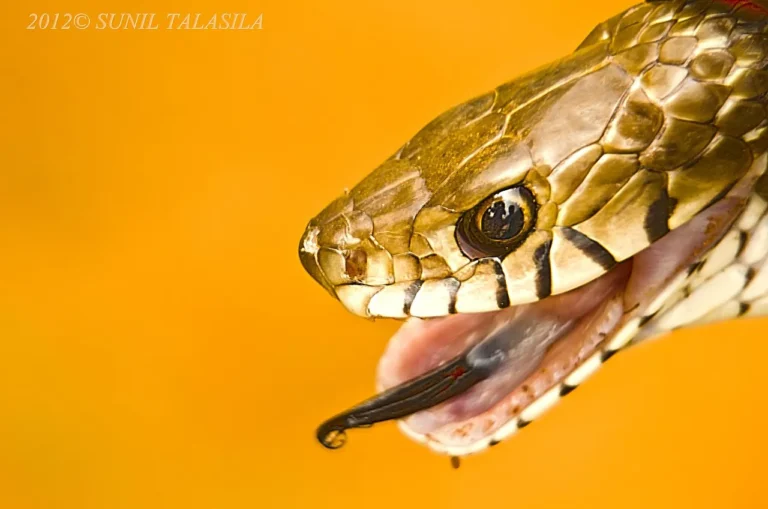Sloth Bear Vs Tiger Who Would Win, Overall Comparison
In a clash between a sloth bear and a tiger, two formidable predators from different families, we delve into the potential dynamics of this confrontation, emphasizing the significant differences in size, weight, strength, speed, senses, and predatory features between these two creatures. This analysis aims to elucidate why a tiger is likely to prevail in a physical encounter with a sloth bear, given its superior attributes and predatory adaptations.
Sloth Bear vs Tiger: Assessing the Likely Victor in a Confrontation
In a confrontation involving a sloth bear and a tiger, the outcome of a fight is heavily influenced by substantial variations in size, weight, strength, speed, senses, and predatory features. While both are formidable in their own right, a tiger would win a sloth bear in a fight due to its larger size, heavier build, greater strength, enhanced speed, superior senses, and predatory adaptations collectively positioning it as the likely victor.
I). Size, Weight, Strength, and Speed Disparities:
– A tiger would win a sloth bear in a fight because it is significantly larger and more robust, weighing between 90 to 310 kg compared to the sloth bear’s 55 to 145 kg. The tiger’s larger size, heavier build, superior strength, and faster speed create a distinct advantage in a physical confrontation.
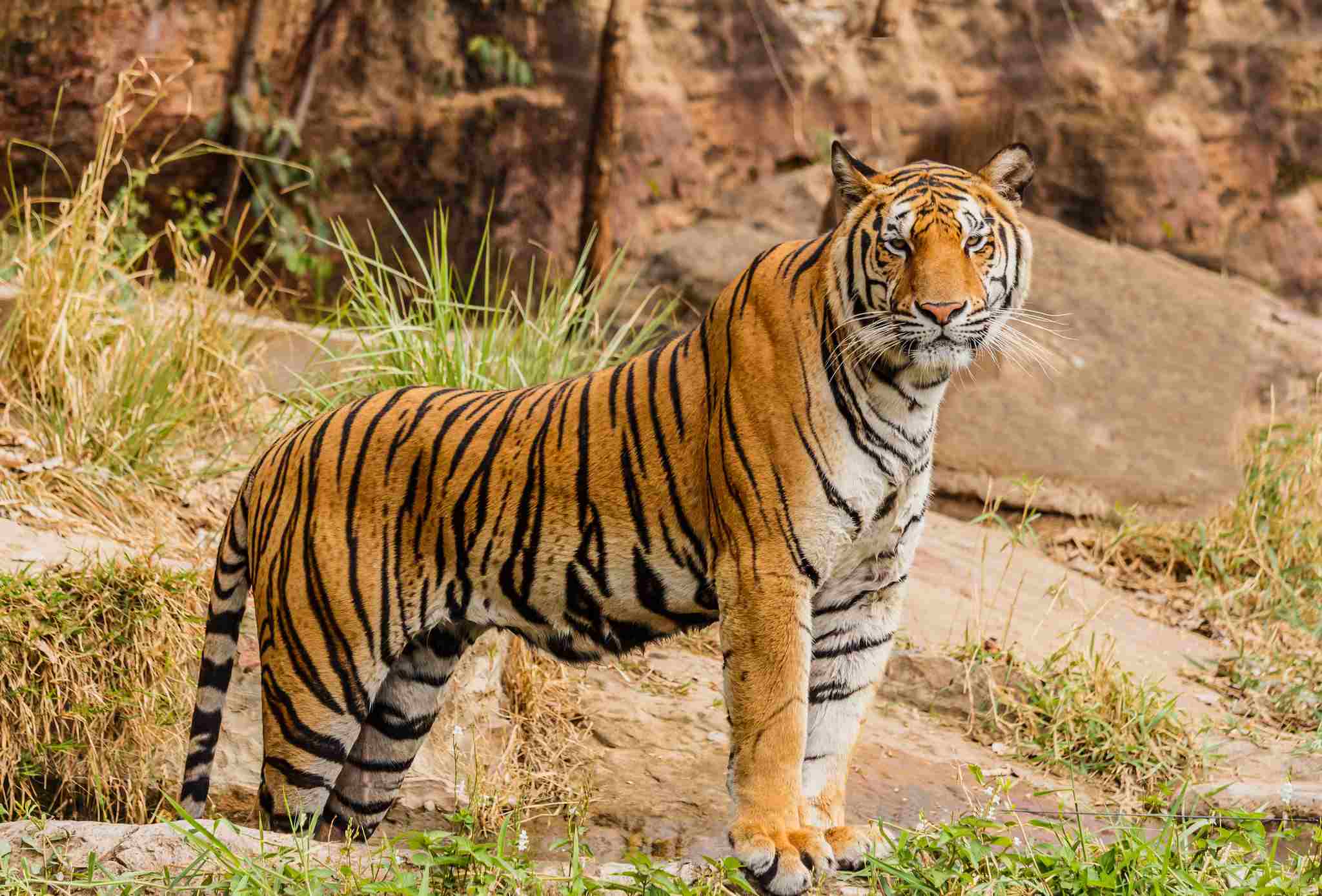
II). Sensory and Predatory Superiority:
– A tiger would win a sloth bear in a fight due to its possession of superior senses, including acute vision, hearing, and a highly developed sense of smell. Additionally, the tiger’s predatory features, such as powerful jaws, sharp claws, and a carnivorous diet, further contribute to its prowess in hunting. In contrast, sloth bears lack the specialized predatory adaptations seen in tigers.
III). Individual and Species-Specific Traits:
– A tiger would win a sloth bear in a fight because individual and species-specific traits play a pivotal role in determining the outcome of a confrontation. The tiger’s innate predatory instincts, honed over generations, provide it with a strategic advantage over the sloth bear in a physical clash.
IV). Potential Strategies of the Sloth Bear:
– A tiger would win a sloth bear in a fight because, despite sloth bears being known for their agility and powerful claws, their potential defensive maneuvers may not effectively counter the tiger’s size, strength, and predatory adaptations.
V). Overall Dynamics:
– In this hypothetical scenario, a tiger is likely to emerge as the victor in a fight against a sloth bear due to its larger size, heavier build, greater strength, faster speed, superior senses, and specialized predatory features. While the sloth bear may employ defensive strategies, the overall dynamics favor the tiger in this hypothetical confrontation.
*Details of Comparison
| Criteria | Sloth Bear | Tiger |
| Taxonomy | Kingdom: Animalia, Phylum: Chordata, Class: Mammalia, Order: Carnivora, Family: Ursidae, Genus: Melursus, Species: Ursinus |
Kingdom: Animalia, Phylum: Chordata, Class: Mammalia, Order: Carnivora, Family: Felidae, Genus: Panthera, Species: Tigris
|
| Appearance | Shaggy fur, black with a cream-colored “V” on the chest, long, curved claws for digging |
Striking orange coat with black stripes, muscular build with retractable claws
|
| Size | Length: 5.5 to 6.5 feet, Height: 2.5 to 3 feet at the shoulder |
Length: 8.2 to 11.2 feet excluding the tail, Height: 3.6 feet at the shoulder
|
| Weight | Typically 220 to 440 pounds |
Males: 400 to 700 pounds, Females: Smaller
|
| Bite Force (PSI) | Not well-documented |
Estimated around 1,050 PSI
|
| Offensive Advantages | Powerful forelimbs and claws for digging, aggressive when threatened |
Sharp claws and strong jaws for hunting and killing prey
|
| Defensive Advantages | Long claws and aggression as a defense mechanism, can stand on hind legs |
Camouflage and agility for defense, powerful hind limbs for quick escapes
|
| Speed | Approximately 25 km/h for short bursts |
Can reach speeds of up to 65 km/h in short sprints
|
| Agility | Agile climbers and proficient at standing on hind legs |
Remarkably agile, capable of navigating varied terrain
|
| Overall Physical Capacity | Well-adapted for digging and climbing, moderately strong build |
Apex predator with superior strength, agility, and hunting capabilities
|
| Habitat Preference | Dense forests, grasslands, and hilly terrains |
Varied habitats including grasslands, savannas, forests
|
| Tracks | Distinctive tracks with claw marks, hind footprints show a distinct heel pad |
Well-defined, rounded paw prints with retractable claws
|
| Lifespan | Approximately 20 to 30 years |
Around 10 to 15 years in the wild
|
| Feeding Behavior | Omnivorous, focusing on insects, fruits, and vegetation |
Carnivorous, preying on various ungulates and mammals
|
| Intelligence | Problem-solving skills, especially in obtaining food |
Highly intelligent predators with strategic hunting techniques
|
| Social Behavior | Mostly solitary with occasional family groups |
Generally solitary except during mating or when raising cubs
|
| Reproduction | Solitary mating, gestation period 6-7 months, 1-3 cubs |
Solitary mating, gestation period 3-4 months, 2-4 cubs
|
| Parental Behavior | Females are primary caregivers, cubs stay for an extended period |
Mothers are dedicated caregivers, teaching cubs hunting and survival skills
|
| Proximity to Humans | Found in proximity to human settlements, potential conflicts |
Tigers may come into conflict when territories overlap, potential danger
|
| Behavior Toward Humans | Generally avoidant but may display aggression if threatened |
Generally avoid human contact, may become aggressive if threatened
|
| Danger Posed to Humans | May pose a threat if cornered or provoked, potential for aggression |
Higher potential danger due to predatory nature, attacks, although rare, can occur
|
| Associated Precautions | Caution required, especially if cubs are present |
Precautions include avoiding direct eye contact, backing away slowly
|
| Conservation Status | Listed as “Vulnerable” on the IUCN Red List |
Conservation status varies, some subspecies are endangered
|
Key Points
- Tigers are significantly larger with a more powerful physique.
- Sloth bears are omnivores with a focus on insects, while tigers are obligate carnivores.
- Tigers exhibit superior strength, agility, and a stronger bite force.
- Both species are generally solitary, but sloth bears may form family groups.
- Tigers pose a higher potential danger to humans compared to sloth bears.
- Both face threats such as habitat loss, poaching, and human-wildlife conflicts.
- Sloth bears are listed as “Vulnerable,” and some tiger subspecies are endangered.
- Reproductive strategies, parental behavior, and intelligence differ between the two species.
1. Taxonomy:
Sloth Bear (Melursus ursinus):
Kingdom: Animalia
Phylum: Chordata
Class: Mammalia
Order: Carnivora
Family: Ursidae
Genus: Melursus
Species: Ursinus
Tiger (Panthera tigris):
Kingdom: Animalia
Phylum: Chordata
Class: Mammalia
Order: Carnivora
Family: Felidae
Genus: Panthera
Species: Tigris
2. Appearance:
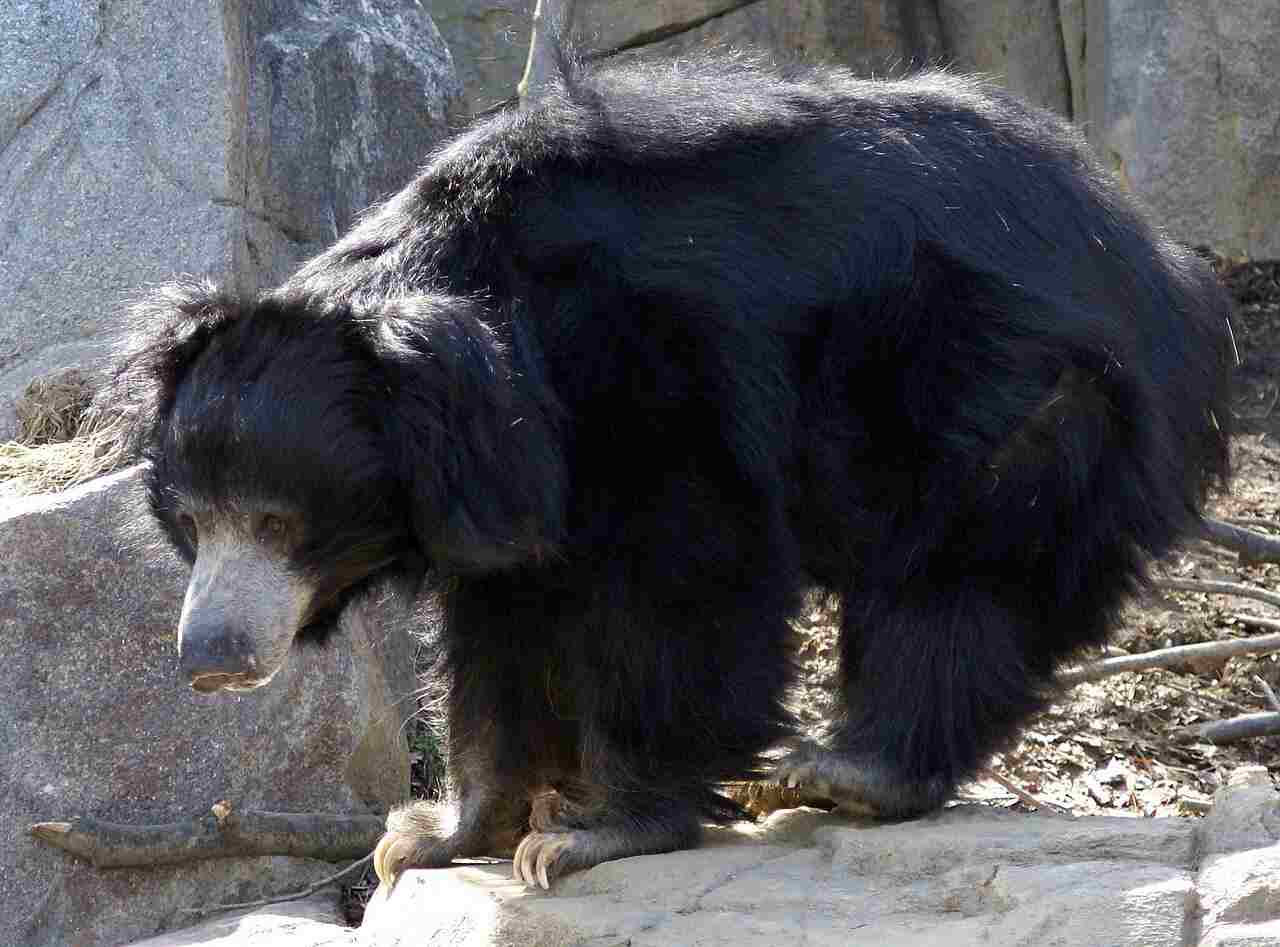
Sloth Bear:
Shaggy fur, typically black with a distinct cream-colored “V” or “Y” shape on the chest.
Long, curved claws for digging and climbing.
Muzzle with a hairless, flexible, and mobile snout.
Tiger:
Striking orange coat with black stripes; some may have a white coat with black stripes.
Muscular build with a powerful and elongated body.
Sharp retractable claws.
Comparison:
The sloth bear has a more shaggy appearance, while the tiger has a sleek and powerful look.
Ecological Implications:
The sloth bear’s shaggy fur may aid in protection against insects and thorny vegetation, adapting to its habitat.
The tiger’s coat provides effective camouflage in various habitats, enhancing its hunting abilities.
3. Size:
Sloth Bear:
Length: 5.5 to 6.5 feet (1.7 to 2 meters).
Height: 2.5 to 3 feet (0.7 to 0.9 meters) at the shoulder.
Tiger:
Length: 8.2 to 11.2 feet (2.5 to 3.4 meters) excluding the tail.
Height: 3.6 feet (1.1 meters) at the shoulder.
Comparison:
Tigers are significantly larger than sloth bears in terms of both length and height.
Ecological Implications:
Size influences the role each species plays in the ecosystem; tigers are apex predators, while sloth bears play a different ecological role.
4. Weight:
Sloth Bear:
Typically 220 to 440 pounds (100 to 200 kilograms).
Tiger:
Varied, with males weighing between 400 to 700 pounds (180 to 320 kilograms) and females being smaller.
Comparison:
Tigers generally have a higher weight range compared to sloth bears.
Ecological Implications:
Weight is a factor in predation dynamics and resource utilization within their respective habitats.
5. Bite Force (PSI):
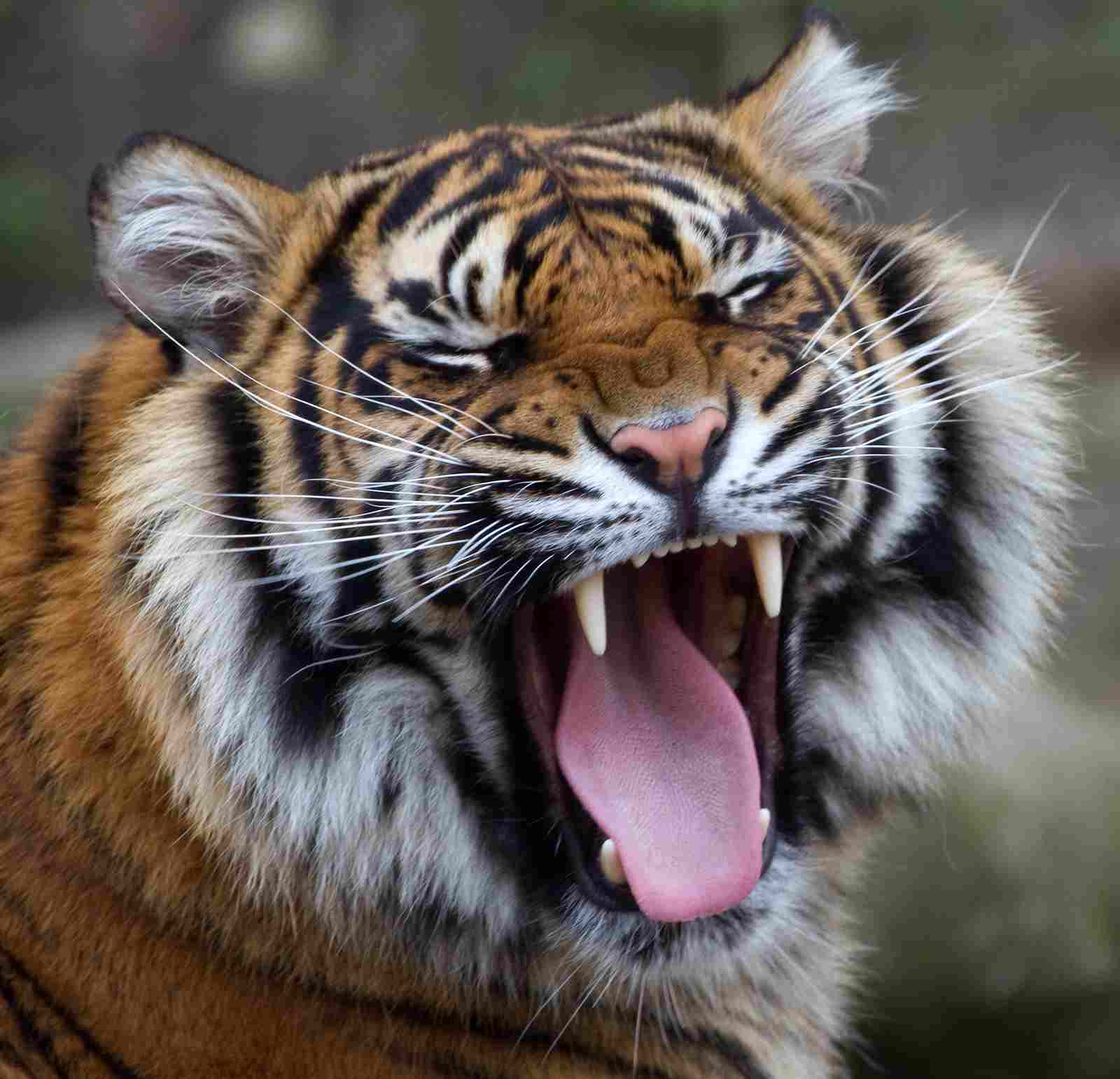
Sloth Bear:
PSI not well-documented but adapted for crushing insects and consuming vegetation.
Tiger:
Estimated to be around 1,050 PSI, a powerful bite force adapted for killing prey.
Comparison:
Tigers have a much stronger bite force compared to sloth bears.
Ecological Implications:
Bite force correlates with hunting strategies and prey preferences, influencing the species’ ecological niche.
6. Physical Offensive Advantages:
Sloth Bear:
Powerful forelimbs and long claws for digging termite mounds and extracting insects.
Can use its powerful forelimbs for defense against threats.
Tiger:
Sharp claws and powerful jaws equipped with strong canines for hunting and killing prey.
Comparison:
While both possess formidable offensive capabilities, the sloth bear’s adaptations are more suited for digging and extracting insects, whereas the tiger’s are designed for hunting larger prey.
Ecological Implications:
These offensive adaptations play a crucial role in the species’ ecological niche, shaping their roles as predators within their ecosystems.
7. Physical Defensive Advantages:
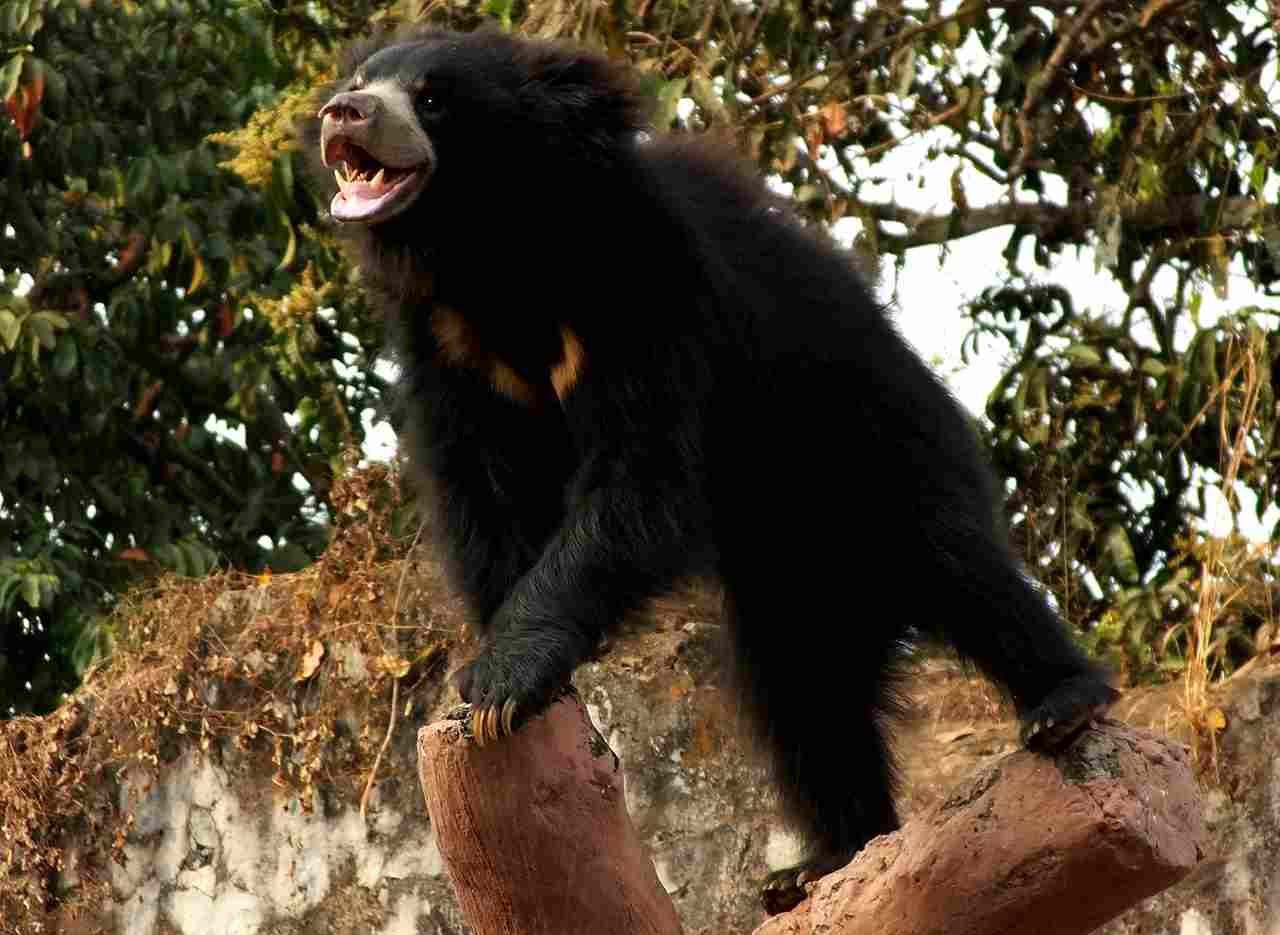
Sloth Bear:
Long claws and aggressive behavior serve as a defense mechanism against predators.
Can stand on its hind legs as a display of intimidation.
Tiger:
Camouflage and agility aid in stalking and ambushing prey, acting as both offensive and defensive mechanisms.
Powerful hind limbs for quick escapes or agile maneuvers.
Comparison:
Sloth bears rely on aggression and standing on hind legs for defense, whereas tigers use a combination of camouflage and agility.
Ecological Implications:
These defensive strategies contribute to the survival and coexistence of each species within their respective habitats.
8. Speed (Km/hour or Mile/hour):
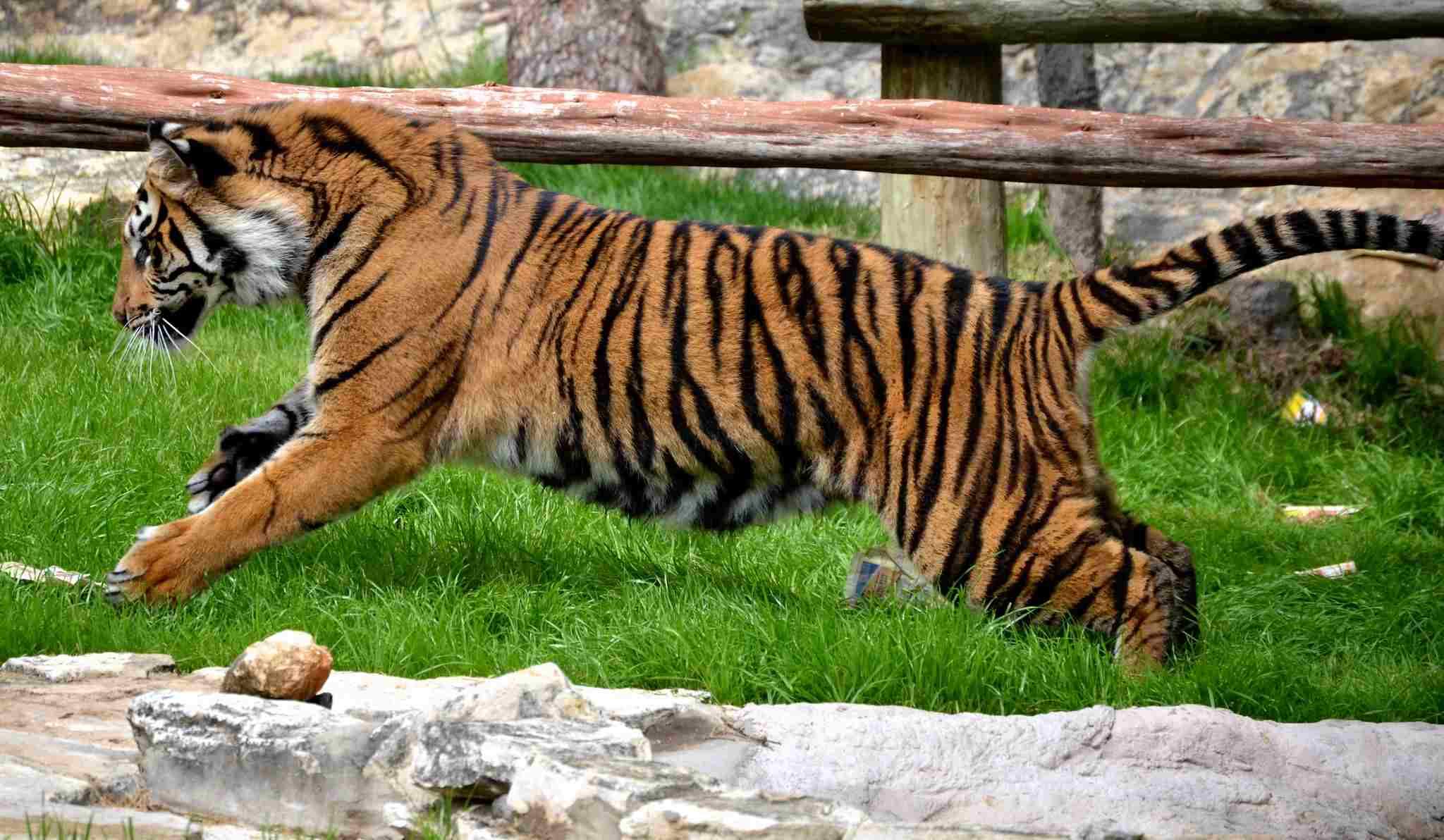
Sloth Bear:
Approximately 25 km/h (15.5 mph) for short bursts.
Tiger:
Can reach speeds of up to 65 km/h (40 mph) in short sprints.
Comparison:
Tigers are significantly faster than sloth bears, providing an advantage in chasing and ambushing prey.
Ecological Implications:
Speed is a crucial factor in the hunting and survival strategies of each species, influencing their roles in the food chain.
9. Agility:
Sloth Bear:
Agile climbers and proficient at standing on hind legs.
Tiger:
Remarkably agile, capable of navigating varied terrain and making precise movements for hunting.
Comparison:
Tigers generally exhibit higher agility compared to sloth bears, essential for their hunting techniques.
Ecological Implications:
Agility is crucial for navigating diverse habitats, avoiding predators, and efficiently capturing prey.
10. Overall Physical Capacity:
Sloth Bear:
Well-adapted for digging and climbing with powerful forelimbs and long claws.
Moderately strong build suitable for its omnivorous diet.
Tiger:
Apex predator with a powerful physique, sharp claws, and strong jaws for hunting large prey.
Superior strength and agility contribute to its role as a top predator.
Comparison:
Tigers exhibit a higher overall physical capacity, suited for capturing and subduing larger prey, while sloth bears excel in specialized activities like digging.
Ecological Implications:
The contrasting physical capacities contribute to the ecological roles each species plays in maintaining balance within their ecosystems.
11. Habitat Preference(s):
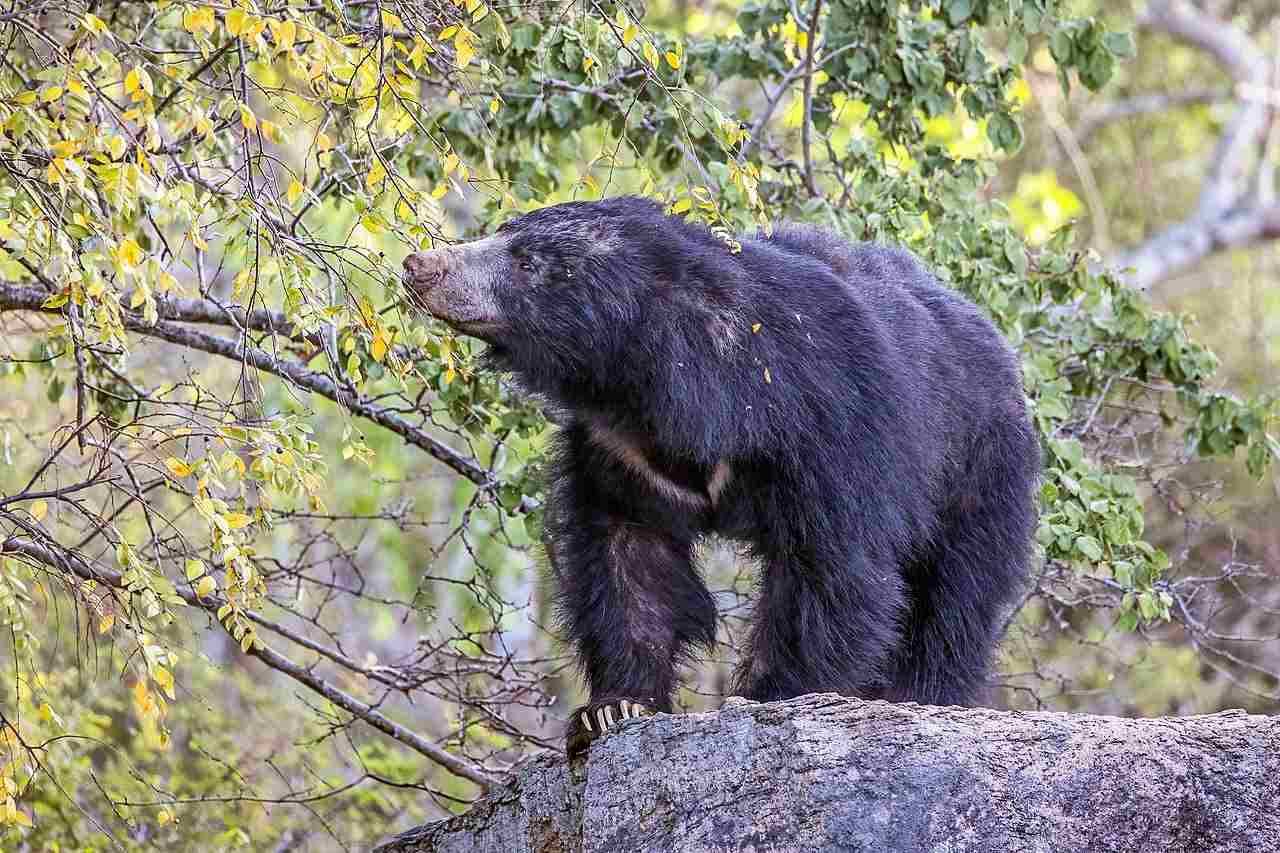
Sloth Bear:
Dense forests, grasslands, and hilly terrains, often near water sources.
Tiger:
Varied habitats including grasslands, savannas, forests, and mangrove swamps.
Comparison:
While both species can inhabit overlapping areas, tigers are more adaptable to diverse environments.
Ecological Implications:
Habitat preferences influence the distribution of these species and their impact on local ecosystems.
12. Tracks:
Sloth Bear:
Distinctive tracks with claw marks, reflecting its digging behavior.
Hind footprints often show a distinct heel pad.
Tiger:
Well-defined, rounded paw prints with retractable claws.
Typically larger than those of sloth bears.
Comparison:
The tracks provide insights into the behavior and movement patterns of each species.
Ecological Implications:
Tracking is essential for understanding the distribution and movements of these species in the wild.
13. Lifespan:
Sloth Bear:
Approximately 20 to 30 years in the wild.
Tiger:
Around 10 to 15 years in the wild.
Comparison:
Sloth bears generally have a longer lifespan compared to tigers.
Ecological Implications:
Lifespan influences the reproductive strategies and population dynamics of each species within their ecosystems.
14. Mode of Feeding:
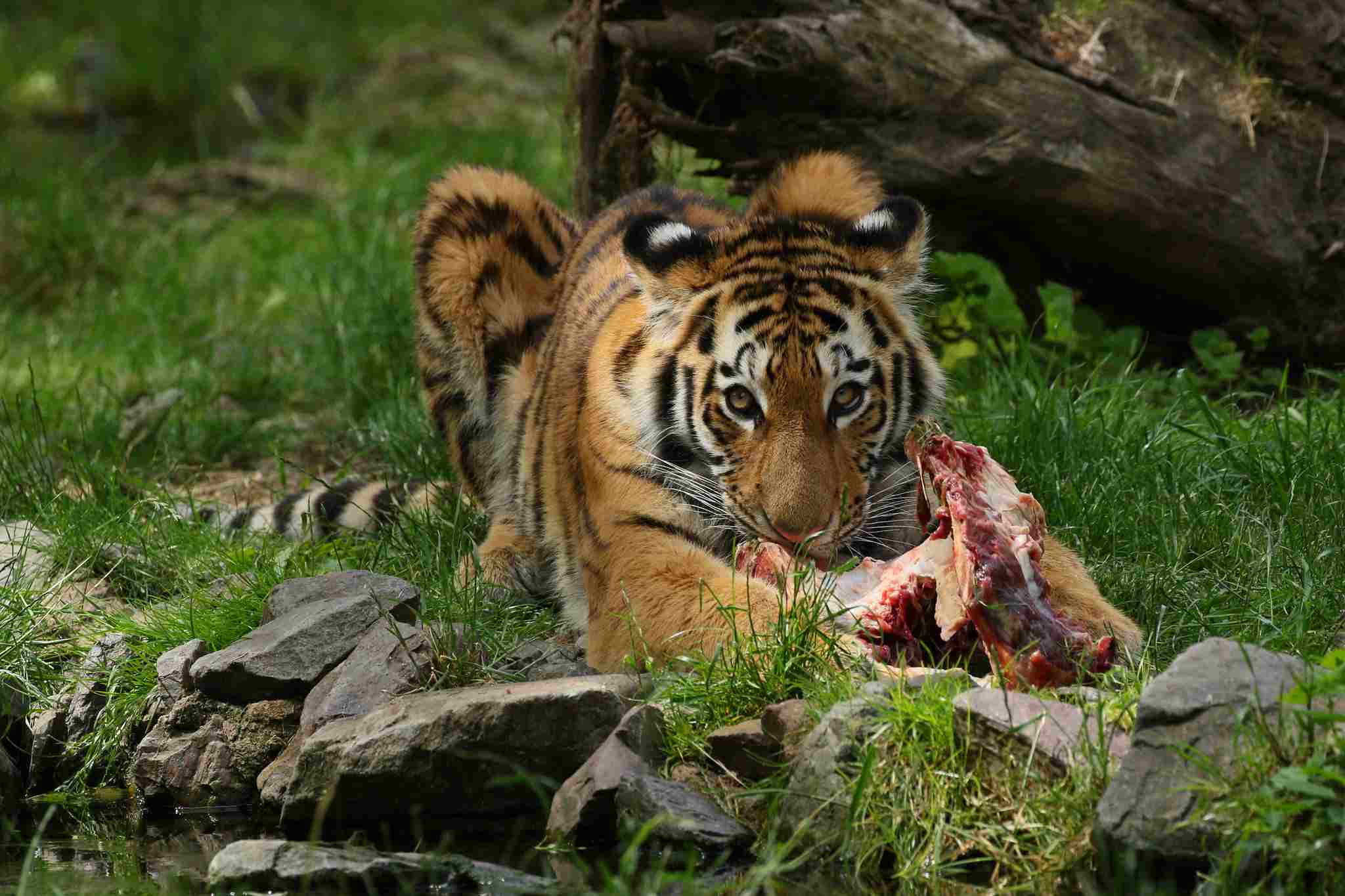
Sloth Bear:
Omnivorous diet, primarily feeding on insects, fruits, and vegetation.
Specialized for termite and ant extraction with their long claws.
Tiger:
Carnivorous diet, preying on various ungulates and other mammals.
Exhibits hunting behaviors such as stalking and ambushing.
Comparison:
Sloth bears are omnivores with a focus on insects, while tigers are obligate carnivores, showcasing different feeding strategies.
Ecological Implications:
Their feeding habits contribute to the regulation of prey populations and impact vegetation in their respective habitats.
15. Intelligence:
Sloth Bear:
Demonstrates problem-solving skills, particularly in obtaining food.
Intelligent adaptations for extracting insects from challenging locations.
Tiger:
Highly intelligent predators with strategic hunting techniques.
Exhibit problem-solving skills in various situations.
Comparison:
Both species exhibit intelligence, but their cognitive abilities are tailored to their specific ecological needs.
Ecological Implications:
Intelligence influences the efficiency of hunting strategies, foraging, and adaptation to changing environmental conditions.
16. Social Behavior:
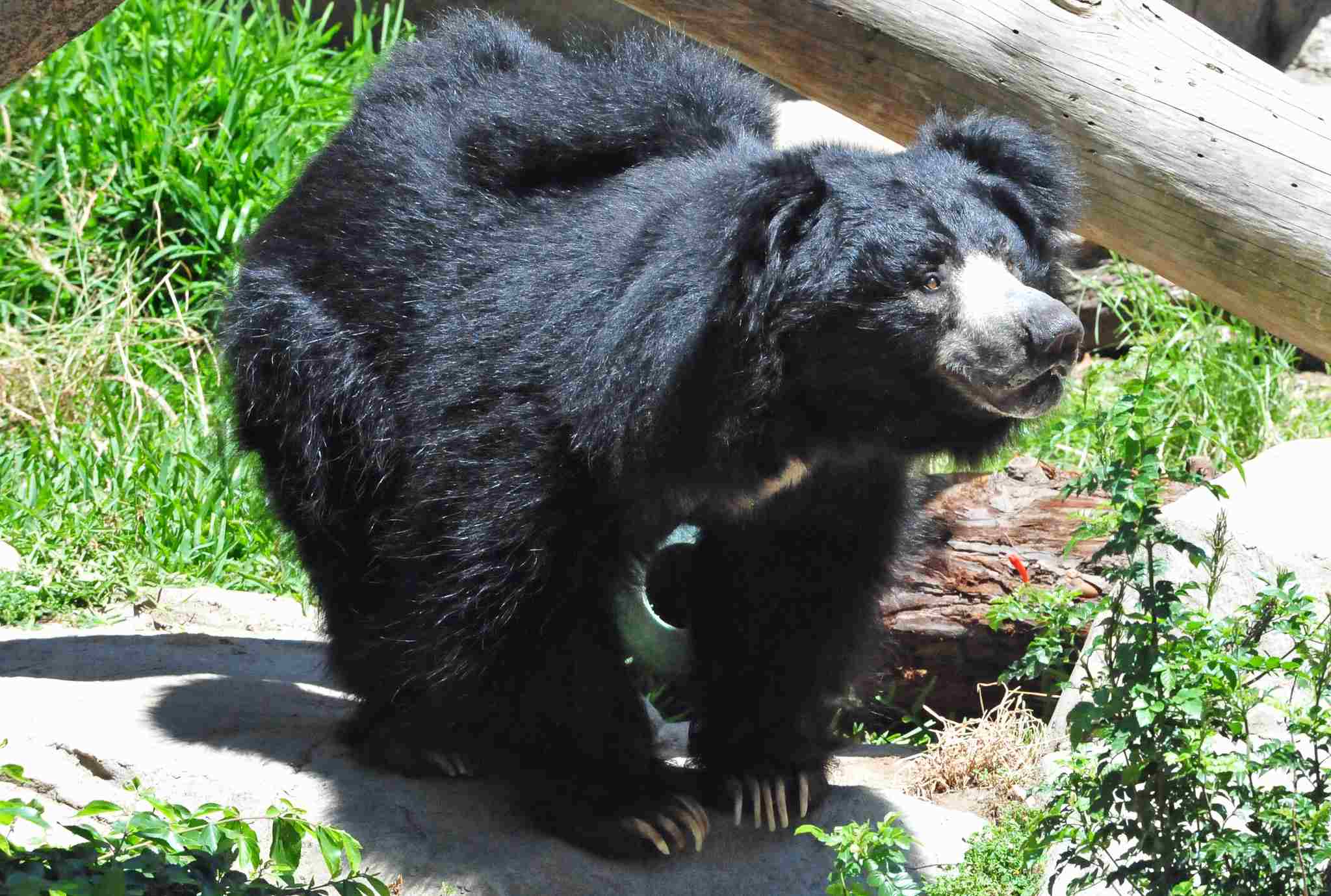
Sloth Bear:
Mostly solitary, with occasional family groups consisting of a mother and cubs.
Males may be more solitary than females.
Tiger:
Generally solitary animals, except during mating or when raising cubs.
Comparison:
Both species tend to be solitary, with limited social interactions.
Ecological Implications:
Solitary behavior affects their ecological footprint, population dynamics, and resource utilization.
17. Mode of Reproduction:
Sloth Bear:
Typically solitary during mating, with a gestation period of about 6-7 months.
Gives birth to 1-3 cubs.
Tiger:
Mating pairs may stay together for a few days, with a gestation period of about 3-4 months.
Litters typically consist of 2-4 cubs.
Comparison:
While there are similarities, such as solitary mating, the gestation period and litter size vary between the two species.
Ecological Implications:
Reproductive strategies influence population dynamics, and the number of offspring affects the species’ impact on the ecosystem.
18. Parental Behavior:
Sloth Bear:
Females are the primary caregivers, protecting and nurturing cubs.
Cubs stay with the mother for an extended period, learning essential skills.
Tiger:
Mothers are dedicated caregivers, teaching cubs hunting and survival skills.
Cubs stay with the mother until they become independent.
Comparison:
Both species exhibit strong maternal care, ensuring the survival and development of their offspring.
Ecological Implications:
Parental behavior influences the success of offspring, affecting the species’ overall population dynamics.
19. Proximity to Human-Inhabited Areas:
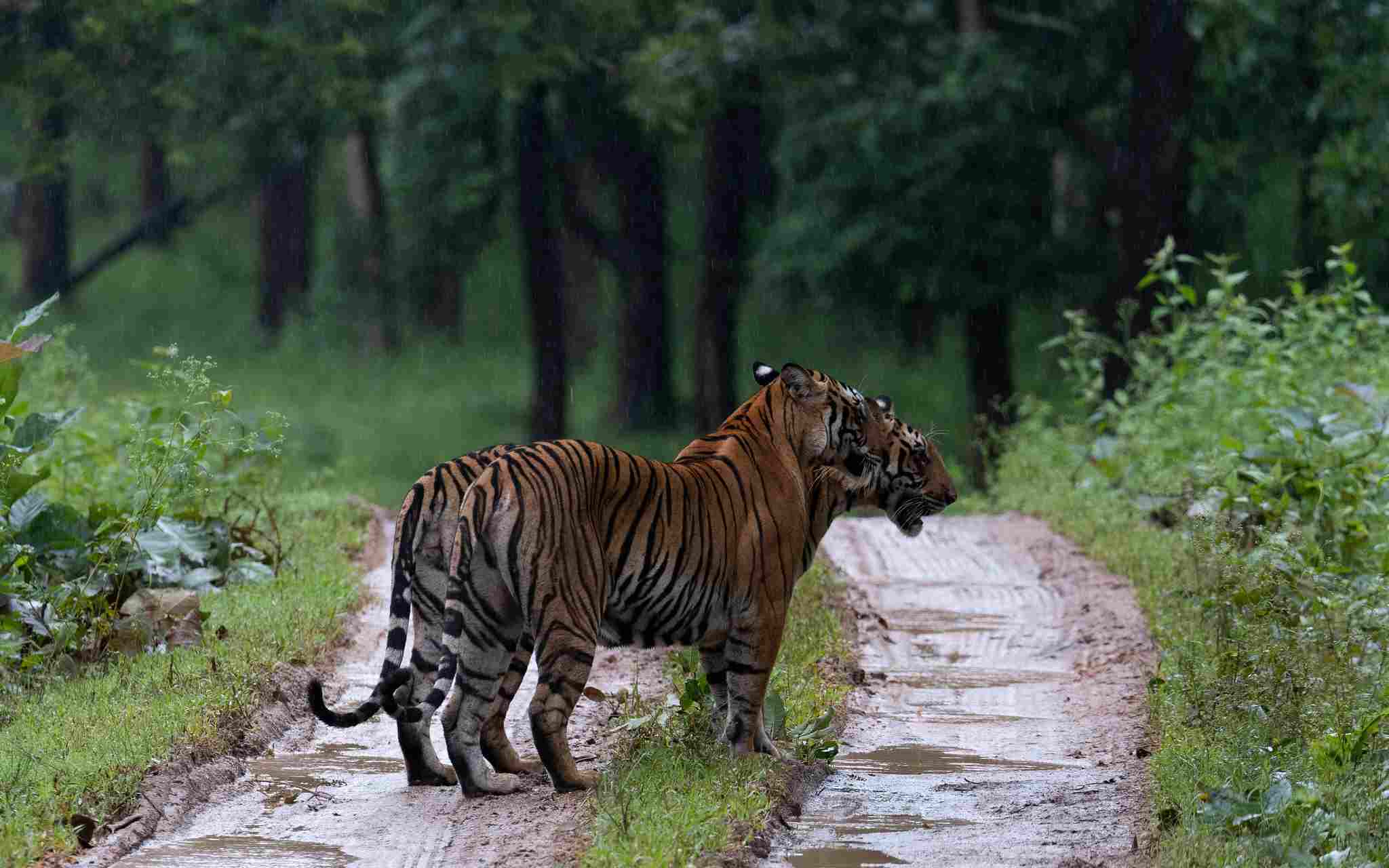
Sloth Bear:
Can be found in proximity to human settlements, especially areas with agriculture.
Encounters may lead to conflicts due to crop raiding.
Tiger:
Tigers may come into conflict with humans when their territories overlap.
Human-tiger conflicts can arise, particularly in areas with habitat fragmentation.
Comparison:
Both species can face challenges when their habitats intersect with human settlements.
Ecological Implications:
Human-wildlife conflicts impact conservation efforts and require strategies to ensure coexistence.
20. Behavior Toward Humans:
Sloth Bear:
Generally avoidant of humans but may display aggression if threatened.
Can be aggressive if surprised or cornered.
Tiger:
Generally avoid human contact, but individual behavior may vary.
Tigers may become aggressive if they feel threatened or if their territory is encroached upon.
Comparison:
Both species typically avoid humans, but aggression can occur in certain situations.
Ecological Implications:
Human interactions can impact the behavior of these species and influence their roles in local ecosystems.
21. Danger Posed to Humans:
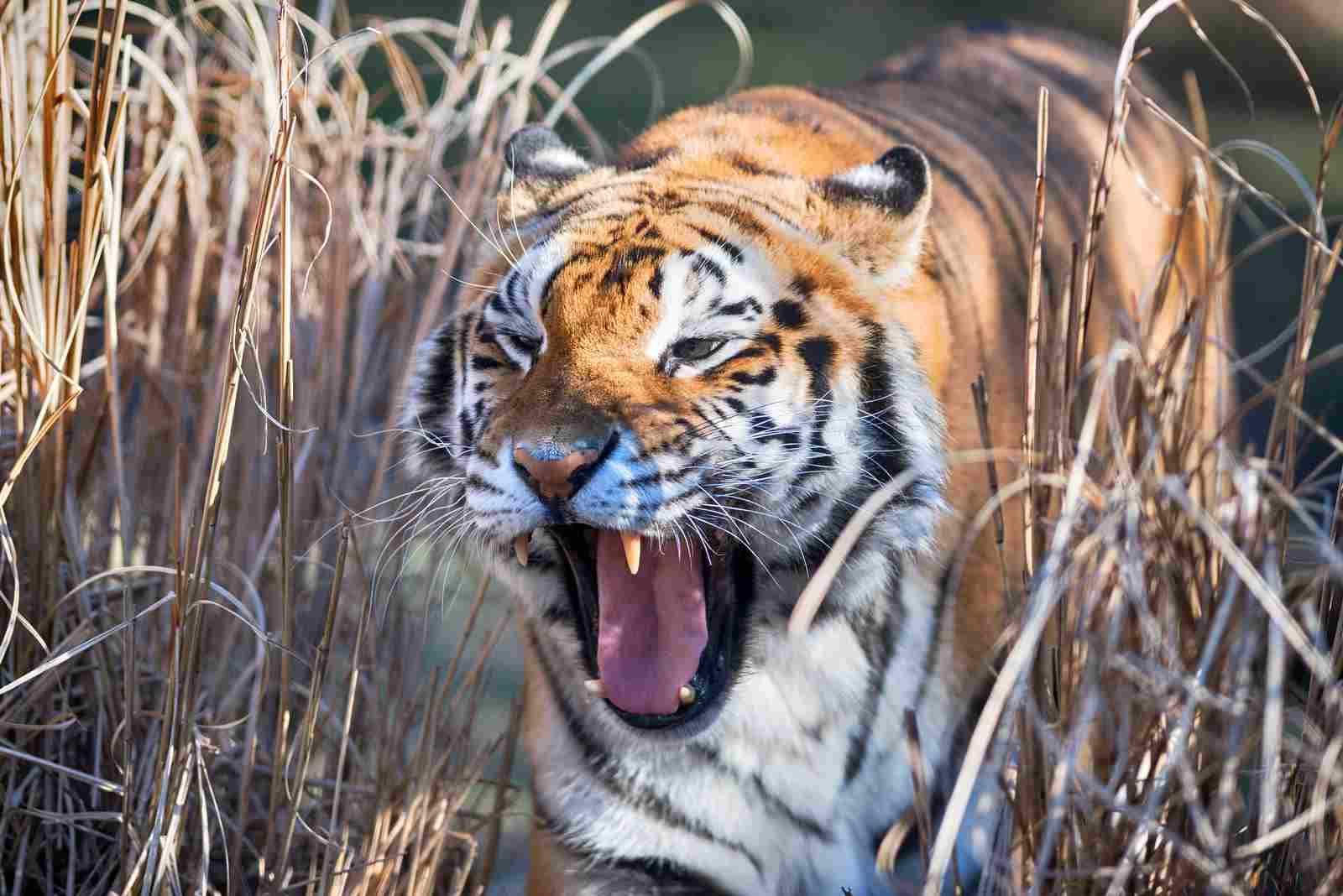
Sloth Bear:
May pose a threat if cornered or provoked, with potential for aggressive behavior.
Typically, human-sloth bear conflicts arise from accidental encounters.
Tiger:
Tigers have a higher potential to pose a danger due to their predatory nature.
Attacks on humans, although rare, can occur in specific circumstances.
Comparison:
Tigers generally pose a higher danger to humans compared to sloth bears.
Ecological Implications:
Understanding the potential danger each species poses to humans is crucial for conservation efforts and human-wildlife conflict mitigation.
22. Associated Precautions:
Sloth Bear:
Caution required in areas with sloth bear presence, especially if cubs are present.
Making noise to alert bears of your presence can prevent surprise encounters.
Tiger:
Precautions include avoiding direct eye contact, backing away slowly if encountered.
Using deterrents such as loud noises to avoid surprise encounters.
Comparison:
Both species require caution, but precautions vary due to differences in behavior and potential danger.
Ecological Implications:
Implementing and promoting responsible behavior around wildlife is crucial for minimizing conflicts and ensuring the safety of both humans and animals.
23. Conservation Status:
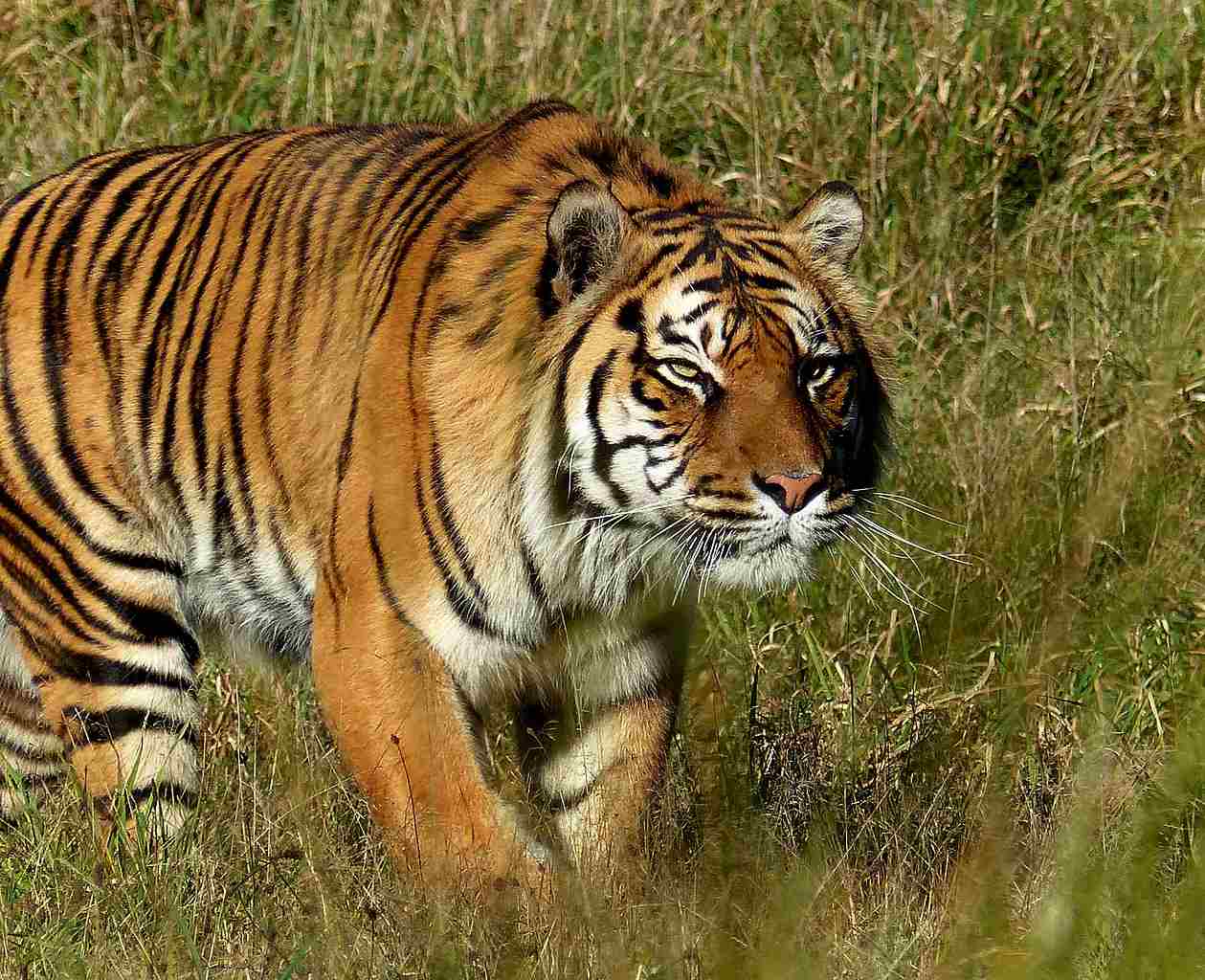
Sloth Bear:
Listed as “Vulnerable” on the IUCN Red List.
Faces threats from habitat loss, poaching, and human-wildlife conflicts.
Tiger:
Conservation status varies among subspecies; some are endangered.
Threats include habitat loss, poaching, and human-wildlife conflicts.
Comparison:
Both species face significant conservation challenges, with habitat loss and human-wildlife conflicts being common threats.
Ecological Implications:
The conservation status of these species reflects broader issues in their respective ecosystems, emphasizing the need for conservation efforts.
Summary of Comparison
Size and Physical Characteristics:
Tigers are significantly larger with a more powerful physique.
Sloth bears have a shaggy appearance and long claws for digging.
Diet and Feeding Behavior:
Sloth bears are omnivores, focusing on insects, fruits, and vegetation.
Tigers are obligate carnivores, preying on various mammals.
Physical Capabilities:
Tigers exhibit superior strength, agility, and a stronger bite force.
Sloth bears are adapted for digging and climbing with powerful forelimbs.
Behavior and Social Structure:
Both species are generally solitary, but sloth bears may form family groups.
Tigers exhibit more complex hunting strategies and communication.
Human-Wildlife Interaction:
Sloth bears may be found in proximity to human settlements, with potential conflicts over crops.
Tigers may come into conflict when territories overlap, posing a higher potential danger.
Conservation Status and Threats:
Both species face threats such as habitat loss, poaching, and human-wildlife conflicts.
Sloth bears are listed as “Vulnerable,” and some tiger subspecies are endangered.
Reproduction and Parental Behavior:
Sloth bears and tigers both exhibit strong maternal care, with females nurturing and protecting their offspring.
Conclusion:
I) Similarities:
Both sloth bears and tigers play crucial roles in their ecosystems as apex predators or omnivores.
Face threats related to habitat loss, poaching, and human-wildlife conflicts.
II) Differences:
Divergent in size, dietary preferences, and behaviors, with tigers being larger and primarily carnivorous while sloth bears are smaller and omnivorous.
Tigers generally pose a higher danger to humans compared to sloth bears.

